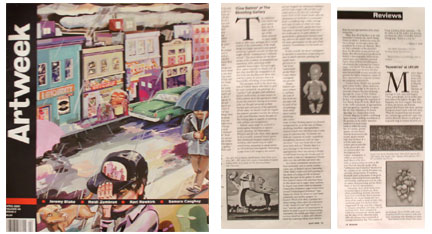
ARTWEEK
"Cine Delirio" at
The Shooting Gallery
April 2005, Volume 36, Issue 3, pages 15-16
By Marisa S. Olson

The exhibition Cine Delirio was more deliro than cine.
It didn't deliver any of the filmic material its name might seem to offer
(save, perhaps, for a consideration of the relationship of the single
image to a larger narrative), but instead served up a quixotic account
of what one might call the "contemporary California surreal".
The press release for the show speaks of the tradition of unexpected
juxtapositions
while promising newly expanded dreamscapes. Viewers might, then, expect
tripped-out kitsch, and, in fact, they wouldn't be too disappointed on
that level, but the four-man show also conveys a sense of cynicism that
is at least mildly refreshing, if not delirious.
The strongest work in the show was that of Nathan Spoor, who likes to
spell his name backwards, on paintings, in a "typeface" half-gangsta,
half-sideshow. Spoor's work seems, in some senses, to hold a mirror up
to the spectator's mind (if not the auteur's), forcing us to reconsider
our thought processes as they become part and parcel of the spectacle.
All the same, we should recall the regard the original surrealists had
for the mirror, as this post-Freudian bunch thought of the looking glass
as capable of sparking only sublime mis-recognitions.
Indeed, some might be inclined to misrecognize themselves in Spoor's acrylic
painting, On Observations, Whispers and the Like. Here, what appears
to be a recently crowned beauty queen (her ceremonial bouquet replaced
by a wedding cake) stands atop an eight-armed nurse, prepared to speak
before an old-fashioned microphone. Borrowing a page from LSD imagery,
the nurse's eyes are bugged-out, blackened windows, and her long tongue
rolls out like a red carpet entry to the face of a suburban home. Each
of the nurse's hands offer the adornments of servitude to a normative
ideal - a wedding ring, a baby carriage and a pair of scales in which
the brain loses a weighty battle against the heart. The piece is among
Spoor's more narrative works and so, to some extent, it spoon-feeds a
particularly feminist reading, whereas the artist's other works call for
more participation on the part of the observer. Nonetheless, it is his
most successful.
In fact, overall, the show's indulgence in narrative is somewhat invigorating
at a time in which narrative painting has largely been ghettoized as "low
brow", particularly on the West Coast, where conceptualism prevails.
Shawn Barber's primary subject is, perhaps, the icon of low-brow art:
the baby doll. In each of his oil paintings, these eerily abject sexless
playthings take center stage, be they floating against an abysmal background
or, as in the case of Release, skydiving, headfirst, sans parachute,
toward
a death that will leave nary a stain upon its suburban site. To Barber,
the dolls are "symbols of youth - superficial, thoughtless characters
with no clear direction." Lest one think this it "just more
baby doll art," Barber slips ina savvy homage to the horrors of
pop appropriation when one among a slough of doll heads littering the
foreground,
in one work, is that of a decapitated Chucky doll - i.e. the doll that
just won't die.
In a funny installation decision perhaps noticeable only to nerdy curator-types,
one of Barber's pieces, Impending Doom, finds a wide-eyed doll
standing at the shore of a tidepool full of donuts, facing that part
of
the gallery in which Eric Joyner's donut-rich paintings hang. In this
shout-out to sugar, these uniformly shaped tasty treats seem to represent
commodity fetishism's sugar-coated drive toward "technological evolution," that
dogma by which we swear we need faster computers and smaller gadgets.
In Joyner's World of the Real, a portrait of a donut-eating robot,
there are references to the "world of a cat" and "world
of a tree," and the spheres of consumption in which we seek to grow
by incorporating, alternately, the worlds and object of others into ourselves
- a fairly self-reflexive move by a painting whose force derives from
it very appropriation of an extant vernacular.
What does all of this have to do with surrealism? Consider the artist's
Sunday Cruise, in which a Technicolor robot drives a concept car
through a dusty villa populated by at least one dinosaur. Here, we find
a reminder of the surrealist's fancy for the union of past, present and
future. But whereas Joyner's predecessors favored a historiography which
encompassed one's very subjective, personal legacy (lines of desire and
phylogenic inheritance), the contemporary redux is much more literal.
This speaks to a fundamental difference between the free-association mode
of early surrealist output and the highly metamorphic nature of later
representation, a rupture between the imaginary and symbolic.
Curator Justin Giarla's ever-quotable press release further advises viewers
to "by all means indulge in the new era of surrealist imagery, but
step cautiously... through the scenes of 'Cine Delirio.' These delights
should be held suspect." In fact, it is tempting to be suspicious
of Lee Harvey Roswell's work, which leans to the cliche and smacks of
appropriation and regurgitation, especially in a piece like his Saint
Sebastian as the Ecstatic Appendage to a Dostoyevskian Grotto (Catholic
Allegory), in which a well-hung figure bearing a striking resemblance
to the portrait on the artist's statement stands in red mesh boxer-briefs
to suffer the erotic fate of a martyr, pinned against a broken bread
stick
by thermometer-like arrows, apples stacked high atop his head. It is
as if the artist must endure pain (a masochistically pleasurable pain,
of
course) to allow the development of a techne - a relegation as selfish
as martyrdom itself. But is it fair for a critic to psychoanalyze an
artist
in this way? Roswell, himself, speaks of the "sublimated sexual impulses" that
lead to the creation of art - a truly Freudian, nay surrealist,
interpretation. If anything, Roswell's work is elucidative of the problematic
relationship between surrealism and morality, making more real the sadistic
nature of spectatorship and the desire latent in feats of representation.
Ultimately, those ideals which cause us to read objects as kitsch are,
themselves, normalizing. In truth, this work leans more towards the dialect
of camp, which the late Susan Sontag said "is a vision of the world
in terms of style - but a particular style. It is the love of the exaggerated."
It may seem like a slippage to juxtapose surrealism and camp, and yet
standing before these exemplars of California contemporary surreal, watching
the edges of the otherwise realist elide into fantasy, one is reminded
of Sontag's elucidation that "The essence of Camp is its love of
the unnatural..." In the midst of all this artifice and delirium,
one hears the echoes of another beloved Sontag quip: "Sanity is
a cozy lie."
Cine Delirio closed March 5 at The Shooting Gallery, San Francisco.
Marisa S. Olson is a contributing editor to Artweek.